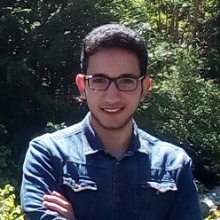Bursik, B., Stierle, R., Oukili, H., Schneider, M., Bauer, G., & Gross, J. (2025). Modelling Interfacial Dynamics Using Hydrodynamic Density Functional Theory: Dynamic Contact Angles and the Role of Local Viscosity.
arXiv Preprint arXiv:2504.03032.
https://doi.org/10.48550/arXiv.2504.03032 Zusammenfassung
Hydrodynamic density functional theory (DFT) is applied to analyse dynamic contact angles of droplets in order to assess its predictive capability regarding wetting phenomena at the microscopic scale and to evaluate its feasibility for multiscale modelling. Hydrodynamic DFT incorporates the influence of fluid-fluid and solid-fluid interfaces into a hydrodynamic theory by including a thermodynamic model based on classical DFT for the chemical potential of inhomogeneous fluids. It simplifies to the isothermal Navier-Stokes equations far away from interfaces, thus connecting microscopic molecular modelling and continuum fluid dynamics. In this work we use a Helmholtz energy functional based on the perturbed-chain statistical associating fluid theory (PC-SAFT) and the viscosity is obtained from generalised entropy scaling, a one-parameter model which takes microscopic information of the fluid and solid phase into account. Deterministic (noise-free) density and velocity profiles reveal wetting phenomena including different advancing and receding contact angles, the transition from equilibrium to steady state and the rolling motion of droplets. Compared to a viscosity model based on bulk values, generalised entropy scaling provides more accurate results, which stresses the importance of including microscopic information in the local viscosity model. Hydrodynamic DFT is transferable as it captures the influence of different external forces, wetting strengths and (molecular) solid roughness. For all results good quantitative agreement with non-equilibrium molecular dynamics simulations is found, which emphasises that hydrodynamic DFT is able to predict wetting phenomena at the microscopic scale.BibTeX
Oukili, H., Ababou, R., Debenest, G., & Noetinger, B. (2021). Multi-scale study of diffusion in composite grain–pore systems based on particles random walk.
Comptes Rendus. Mécanique,
349, Article 3.
https://doi.org/10.5802/crmeca.94 Zusammenfassung
This paper studies diffusion processes at different scales in two-dimensional (2D) composite media (grain-pore porous micromodels). To model diffusion, this study uses the random walk particle tracking (RWPT) method based on 2D analytical solutions in finite and semi-infinite domains with zero-flux boundary conditions (BC) at grain boundaries. The analytical solutions are developed using a method of images. Then, an RWPT combined to a Stop&Go algorithm is derived from these analytical solutions. The developed RWPT algorithm is then used to model diffusion processes inside the pores at the "microscopic" level (microscale), while the grain elements are assumed inaccessible to diffusion (zero-flux BC condition at the interface grain/pore). The composite medium, where the diffusion occurs, is a numerical micromodel made of periodic motifs of rectangular grains. Particles are initially located at the center of a pore, and diffuses in the periodic motifs micromodel (infinite domain). First, the grains are chosen square with different sizes to vary the porosity. Second, for constant porosities, the grains are elongated to study the effect of the anisotropy ratio on diffusion processes. Effective macroscale properties (porosities, effective diffusion tensors, tortuosities) are then calculated using moments of particles positions. The results obtained fit well with theoretical expectations and are in very good agreement with results found in the literature.BibTeX
Oukili, H., Ababou, R., Debenest, G., & Noetinger, B. (2019). Random Walks with negative particles for discontinuous diffusion and porosity.
Journal of Computational Physics,
396, 687–701.
https://doi.org/10.1016/j.jcp.2019.07.006 Zusammenfassung
This study develops a new Lagrangian particle method for modeling flow and transport phenomena in complex porous media with discontinuities. For instance, diffusion processes can be modeled by Lagrangian Random Walk algorithms. However, discontinuities and heterogeneities are difficult to treat, particularly discontinuous diffusion D(x) or porosity θ(x). In the literature on particle Random Walks, previous methods used to handle this discontinuity problem can be characterized into two main classes as follows: "Interpolation techniques", and "Partial reflection methods". One of the main drawbacks of these methods is the small time step required in order to converge to the expected solution, particularly in the presence of many interfaces. These restrictions on the time step, lead to inefficient algorithms. The Random Walk Particle Tracking (RWPT) algorithm proposed here is, like others in the literature, discrete in time and continuous in space (gridless). We propose a novel approach to partial reflection schemes without restrictions on time step size. The new RWPT algorithm is based on an adaptive "Stop&Go" time-stepping, combined with partial reflection/refraction schemes, and extended with a new concept of negative mass particles. To test the new RWPT scheme, we develop analytical and semi-analytical solutions for diffusion in the presence of multiple interfaces (discontinuous multi-layered medium). The results show that the proposed Stop&Go RWPT scheme (with adaptive negative mass particles) fits extremely well the semi-analytical solutions, even for very high contrasts and in the neighborhood of interfaces. The scheme provides a correct diffusive solution in only a few macro-time steps, with a precision that does not depend on their size.BibTeX


